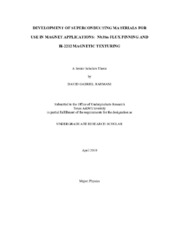| dc.description.abstract | The objective of this study was to develop techniques to be used in the manufacture of
superconducting round wires for use in magnet applications. Nb3Sn and Bi-2212 are
superconducting materials currently being developed for the next generation of magnet
technology. Flux pinning in Nb3Sn has yet to be optimized, and the current carrying
capacity of Bi-2212 is significantly lower than what is needed for practical use in high
field magnets. Processes developed for the manufacture of Nb3Sn and Bi-2212 as round
wires are presented and discussed.
Processes were developed to increase flux pinning in Nb3Sn by utilizing powder
metallurgy techniques to introduce a heterogeneously homogenous distribution of
nanoscale inclusions of candidate materials in Nb rod. The Nb rod is to be used in the
fabrication of high-performance Nb3Sn superconducting wire via a Powder-in-Tube
method, in which the inclusions would act as artificial pinning centers. Consolidation of
the powders via cold isostatic pressing proved problematic due to the high oxygen content of commercially available Nb powder. Severe plastic deformation of Nb was
investigated as a method to produce low oxygen content Nb powder. The prospect of
using an inductively coupled plasma torch to remove the oxygen from commercially
available Nb powder is also discussed.
An attempt was made to increase the current carrying capabilities of Bi-2212 by
developing a procedure for magnetically texturing Bi-2212 powder with the goal of
producing an Ag/Bi-2212 multifilamentary round wire with superior properties in high
magnetic fields. In currently produced Bi-2212 wires, the conducting planes of each
crystal are poorly aligned, and as a result, current transport is diminished. This project
involves suspending Bi-2212 in a liquid solution on a substrate in the presence of a
magnetic field in order to texture the deposited powder. This is possible because of the
anisotropic magnetic susceptibility of Bi-2212. The solvent is then evaporated, leaving
only the Bi-2212 powder on the substrate. The development of this process entailed
optimizing the deposition method and observing the magnetic orientation of the powder. | en |


